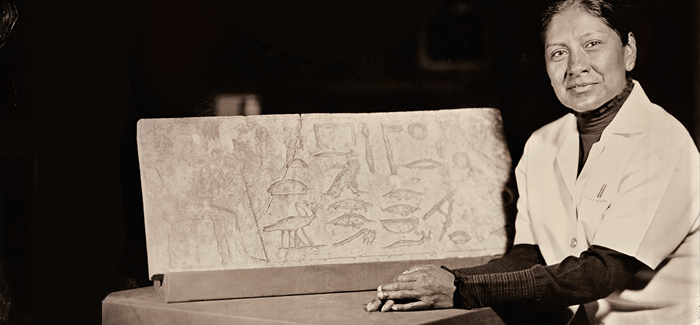
Manicurist Gloria Margarita Tovar with a relief of an elite Egyptian manicurist from 2430 BC; images of men giving manicures and pedicures appear in many tombs. (Photography by Jason Reblando)
An exhibit at the Oriental Institute Museum pairs modern workers with the ancient tools of their trades.
In one photograph, a crisply uniformed Chicago police officer, brass buttons gleaming, gazes from under the brim of his cap as he stands beside a 3,000-year-old figurine of a police chief from western Thebes, whose own official robes are folded carefully over his granite knees. In another photo, a clockmaker in a grimy work apron and optic visor poses with an ancient Egyptian water clock. A cowboy with his lariat and hat leans up next to a 2,500-year-old horse bit from the ancient Iranian city of Persepolis. A makeup artist sits with her canisters of brushes and a Nubian cosmetic palette that was used 5,000 years ago to grind malachite into green eye shadow. A poet with a tablet from the Epic of Gilgamesh, a farmer with a clay sickle from southern Mesopotamia, a funeral director with an ossuary—a “bone box”—from the West Bank.
In all, there are 24 of these images, pairing contemporary professionals with the ancient tools of their trades, in the Oriental Institute’s current exhibit Our Work: Modern Jobs—Ancient Origins. Standing amid them in the museum’s front gallery, it’s hard not to feel moved. The past persists in such small and ordinary ways; a simple workday spent baking bread or driving a cab can contain eons of human history. “One thread through this is the dignity of work,” says OI Egyptologist Emily Teeter, PhD’90, who co-organized the exhibit with OI chief curator Jack Green. “These jobs have been around forever.” Many date almost to the beginning of civilization, an idea that’s accentuated by the exhibit’s use of tintype photography. “So for somebody like Mario Silva, who’s a baker at the Medici,” Teeter says, “for him to think about the fact that he’s part of thousands and thousands of years of people doing that same job—that’s really something.”
Teeter and Green compiled a list of jobs whose ancient roots could be concretely illustrated with an artifact from the museum’s collection. Then they recruited professionals—most from around Chicago, with the exception of Patrick Conway, AM’78, co-owner of Cleveland’s Great Lakes Brewing Company—to come in and sit for a photograph and talk a bit about the connection they felt to the artifact beside them. For many, it was the first time they’d thought about the historical scope of their livelihoods; for others, that perspective was already familiar. “There is a constancy here,” Illinois appellate court justice John B. Simon told OI interviewer Matthew Cunningham as he stood, arms crossed in his black robes, beside a towering cast of the law code of Hammurabi, “a linkage of past and present through the immutable, tangible expression graven in this stele.”
which collects books, artifacts, letters, diaries, and logbooks from soldiers. In the photo, he stands beside the Sennacherib Prism from ancient Iraq, a six-sided clay artifact from 689 BC, documenting, in tightly scripted cuneiform, the military campaigns of Assyrian king Sennacherib. In his hands, Clarke holds a logbook from 2007 that belonged to US soldiers fighting al-Qaeda insurgents in Iraq. The book is a moment-by-moment record of everything the soldiers did and saw: orders and actions, battles and casualties.
Over the years, Clarke said in his OI interview, he has returned to the museum many times to visit the Sennacherib Prism, one of the earliest histories of its kind. “You are dealing with one of the first times when human beings were documenting their exploits and battles, so to speak, or what happened.” Two millennia later, that’s the work Clarke does every day.
Our Work runs through February 23. Some artifacts are on display with the photographs; a map leads visitors to the others, in galleries throughout the museum.
Video
Photographer Jason Reblando discusses the process of creating tintypes for Our Work: Modern Jobs—Ancient Origins.
